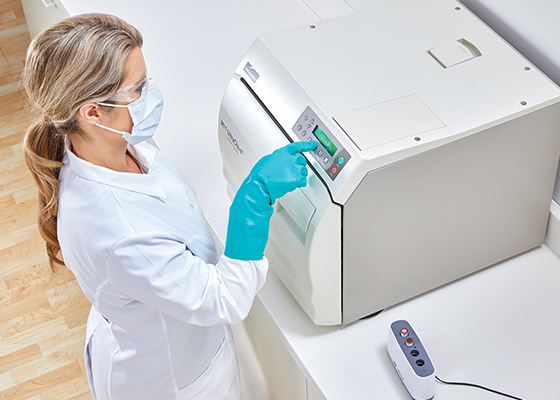Who wrote the reference book “Le chirurgien dentiste” from 1728?
Brain of the Week – History


Take a closer look at leading recommendations on sterility quality assurance for your dental practice.
Infection prevention is a crucial part of patient safety in all clinical settings, including dental offices. The cleaning and sterilization of reusable critical instruments is an important element of your infection prevention program, helping to prevent patient-to-patient disease transmission. In their Interim Infection Prevention and Control Guidance for Dental Settings During the COVID-19 Response (CDC, 2020), the CDC shares that sterilization protocols do not vary for respiratory pathogens, and that DCHP should follow the guidance on device reprocessing found in the Guidelines for Infection Control in Dental Health Care Settings – 2003 (CDC, 2003). This is good news, however, ECRI identified “infection risks from sterile processing errors in medical and dental offices” as #3 on their list of Top 10 Health Technology Hazards for 2020. (ECRI Institute, 2019) So, as your dental practice resumes patient care and reviews your Infection Prevention programs to ensure the safety of both personnel and patients, take the opportunity to assess your device reprocessing and sterilization monitoring practices.
A comprehensive sterility quality assurance program includes the use of physical, chemical, and biological monitors. The routine use of these monitoring tools helps verify the efficacy of sterilization cycles at your facility. More good news – when developing your QA program, you don’t need to start from scratch! CDC guidelines and national standards provide recommendations on the use of these essential monitoring tools.
In the United States, ANSI/AAMI ST79:2017 Comprehensive guide to steam sterilization and sterility assurance in health care facilities (Association for the Advancement of Medical Instrumentation, 2017), is the ‘go to’ standard for steam sterilization. The consensus committee that authors this standard includes end-users, FDA representatives, industry, and professional associations including the American Dental Association. AAMI ST79:2017 devotes an entire section to quality control and provides detailed recommendations on sterilization process monitoring. For example, when discussing physical monitors, it recommends using only sterilizers with recording devices (e.g. having a printer or USB), something to keep in mind if a new sterilizer is on your clinic’s wish list.
Chemical indicators (CIs) are another tool used to help detect sterilization process failures. External chemical indicators help staff differentiate processed from unprocessed items. AAMI ST79:2017 recommends the use of an external indicator on each package, unless, as is the case with paper-plastic peel pouches, the internal chemical indicator is visible.
Internal chemical indicators, as the name implies, are placed inside each package or tray to assist in the detection of potential sterilization failures that could result from incorrect packaging, incorrect loading of the sterilizer, or malfunctions of the sterilizer. AAMI ST79:2017 recommends the preferred use of a Type 5 or Type 6 internal chemical indicator.
Biological indicators (BIs) contain a large population of live bacterial spores that are highly resistant to the sterilization process. In the case of steam sterilizers, the use of BIs containing Geobacillus stearothermophilus spores is recommended. AAMI ST79:2017 states, “Biological indicators are the only sterilization process monitoring device that provide a direct measure of the lethality of the sterilization process.” The CDC (CDC, 2003) and AAMI ST79:2017 recommend that steam sterilizers be tested with a biological indicator at least weekly. In addition, any sterilization loads containing implantable devices should be monitored with a BI and the load quarantined until the result is available. Consult with the sterilizer and BI manufacturers to ensure that you are using a BI suitable for the table-top sterilizer cycle(s) being tested.
Self-contained BIs consist of spores on a carrier and an ampoule of growth media both enclosed in an outer sleeve. Self-contained BIs facilitate convenient in-office incubation, permitting you to know quickly whether the sterilization cycle was adequate to kill a large number of highly resistant bacterial spores. After sterilization, the BI is activated (immersing the spores in the growth media) and incubated at the appropriate temperature. If the microorganisms fail to grow in the specified incubation period, a negative result is observed and recorded, and, provided the physical and chemical monitors also had acceptable results, it is concluded that the sterilization process was successful.
While once a week spore testing using a mail-in spore strip may be compliant with national guidelines, the current state of the art is the use of rapid readout biological indicators which facilitate completion of biological testing and documentation right in the clinic within hours. Why not consider introducing rapid BI monitoring, the same sterilization assurance technology used in hospitals, to your practice? With a BI result in just 24 minutes, you’ll know results before releasing instruments for use, so you can start each consult with confidence.
Watch an archived webinar by 3M’s Jamie Vadnais, LDH, BS RP Part 4 3M Health Care Academy.
Device reprocessing in the dental setting is a multifaceted topic and this blog focused only on sterilization QA practices. For a broader perspective, check out this informative article by Joyce Moore BSDH, RDH, CRCST.
Want to conduct a self-assessment of your clinic’s device reprocessing and sterilization monitoring practices? Take advantage of the free checklist (see Section II.6) in the CDC’s Summary of Infection Prevention Practices in Dental Settings Basic Expectations for Safe Care, (CDC, 2016).



Want to learn more about dental sterilization standards and 3M’s sterilization monitoring solutions? Contact a 3M representative today.
Sources
Association for the Advancement of Medical Instrumentation. (2017). ANSI/AAMI ST79:2017. Arlington, VA: AAMI.
MMWR December 19, 2003 / 52(RR17):1-61. Guidelines for Infection Control in Dental Health-Care Settings — 2003 | CDC. (2003, December 12)
Summary of Infection Prevention Practices in Dental Settings Basic Expectations for Safe Care | CDC. (2016, October)
Interim Infection Prevention and Control Guidance for Dental Settings During the COVID-19 Response | CDC. (2020, May 19)
Top 10 Health Technology Hazards for 2020 | ECRI Institute. (2019)

Brain of the Week – History

Brain of the Week – Chemistry

Brain of the Week – Fun Facts